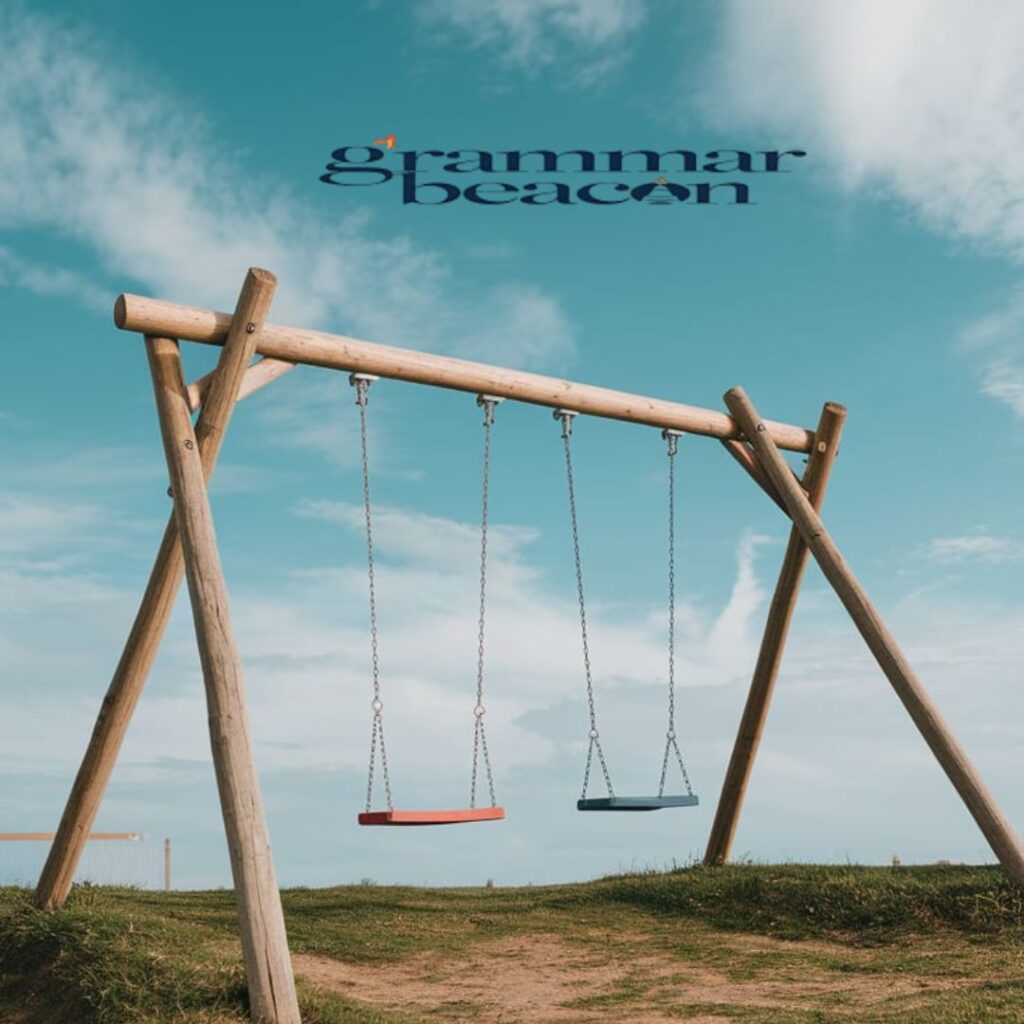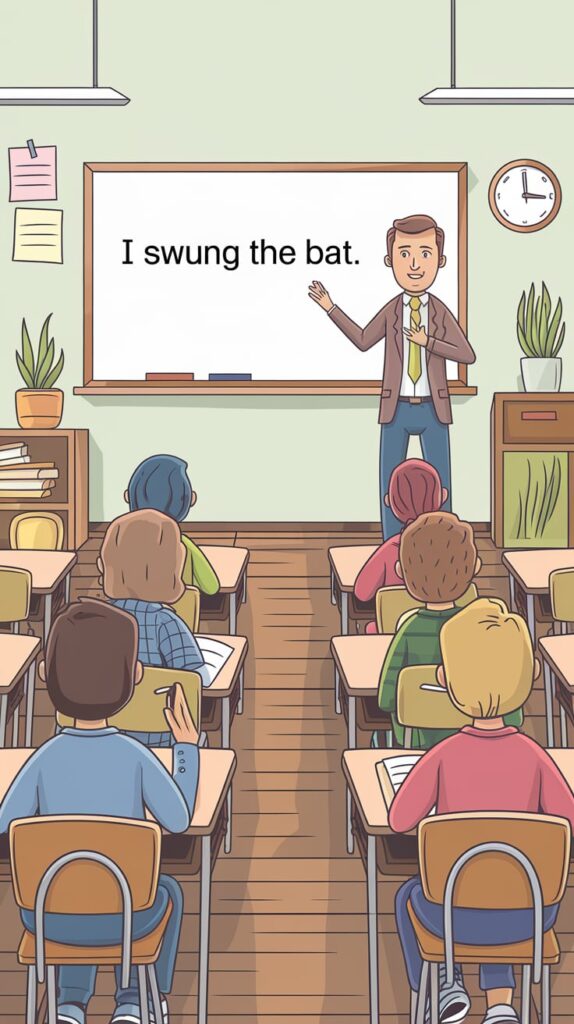Understanding verb tenses is a cornerstone of mastering any language, and English is no exception. The past tense of swing stands out, particularly because of its irregular nature.
So, the past tense of swing. Is it swing, swang, or swung? In this article, we’ll delve deep into this verb, exploring its forms, meanings, pronunciations, and various scenarios where it’s used.
read more : Pre vs Post: Which Prefix to Use? – Grammar Beacon

Understanding the Verb “Swing”
What Does the Word “Swing” Mean?
At its core, the verb “swing” describes a rhythmic movement from side to side or back and forth. Picture a child gleefully moving on a swing at a playground, their laughter echoing with each arc through the air.
This physical sense of swinging captures its literal meaning perfectly.
However, the term also holds metaphorical significance. For instance, in discussions about emotional states or opinions, you might say someone’s mood has “swung” from happiness to sadness, illustrating the dynamic nature of feelings. The flexibility of this word adds richness to both spoken and written language.
Pronunciation of “Swing” and “Swung”
To use the verb correctly, it’s important to master its pronunciation:
- Pronouncing “swing”: The phonetic spelling is /swɪŋ/. The vowel sound is short, similar to the word “ring.”
- Pronouncing “swung”: The phonetic spelling is /swʌŋ/. This vowel sound is more like the word “hung.”
Getting these pronunciations right ensures clarity in communication, especially when speaking with others who may not be familiar with the verb’s forms.
read more : What’s the Plural of Software? Is it Software or Softwares? – Grammar Beacon
The Past Tense: Swung
So, what is the past tense of swing? The answer is “swung.” Unlike regular verbs that simply add “-ed” to form the past tense, “swing” is classified as an irregular verb.
This irregularity can be confusing for learners, but recognizing the correct form “swung” is essential.
Why the Past Tense is “Swung”?
The reason the past tense is “swung” rather than “swang” or another variation lies in the historical development of the English language. Over time, many verbs evolved from their Old English roots, adopting unique conjugation patterns.
“Swing” traces its origins to Old English and has maintained this irregular form throughout its usage.
Understanding these historical nuances can deepen your appreciation for the language and help you remember how to use such verbs correctly.
read more : Skill-Set vs Skillset – Grammar Beacon

A Simple Tense Table
To clarify how “swing” functions in different tenses, here’s a simple tense table:
| Tense | Example |
| Present | I swing. |
| Past | I swung. |
| Present Continuous | I am swinging. |
| Past Continuous | I was swinging. |
| Present Perfect | I have swung. |
| Past Perfect | I had swung. |
This table illustrates the various forms of the verb, providing a handy reference for learners.
Using “Swing” and “Swung” in Sentences
Using “Swing” in a Sentence:
- “Every evening, I swing on the porch while sipping my tea.”
- “During the summer, children swing on the playground swings.”
- “As the sun sets, I often swing my legs over the edge of the dock.”
- “Yesterday, I swung the door open to let the fresh air in.”
- “Last weekend, we swung by the local market to pick up some fruits.”
- “He swung his arms wildly as he danced to the music.”
These examples demonstrate how “swing” and “swung” can be integrated into everyday language, making it easier to remember their usage.
read more : Requester or Requestor Spelling – Grammar Beacon
Exploring Different Past Tenses
To grasp the full scope of “swung,” let’s take a closer look at various forms of past tense through different scenarios. Each type adds a unique layer of meaning to the action being described.
Simple Past
The simple past conveys actions that have been completed. For example:
- “I swung the bat during the game.”
This form is straightforward and often the first one learned in English classes. It’s ideal for narrating events that have already taken place.
Past Continuous
The past continuous indicates an ongoing action in the past. For instance:
- “I was swinging on the swing when it started to rain.”
This tense provides a sense of duration, often setting the stage for another action or event that interrupts it.
read more : Scrapped vs Scraped – Grammar Beacon

Past Perfect
The past perfect expresses an action that was completed before another action in the past. An example would be:
- “By the time I arrived, they had already swung into action.”
Here, it emphasizes the sequence of events, highlighting what happened first.
Past Perfect Continuous
The past perfect continuous shows the duration of an action up until a certain point in the past. For example:
- “They had been swinging for hours before the sun went down.”
This adds depth to the timing and duration of the action, giving listeners or readers a clearer picture of the events.
Common Contexts for “Swing” and “Swung”
Let’s explore various contexts in which “swing” and “swung” are commonly used, providing a richer understanding of how these verbs function in everyday life.

Playground Scenario
Imagine a group of children at a playground.
- Present: “The kids swing back and forth on the swings.”
- Past: “Yesterday, they swung high into the air, laughing joyfully.”
In this context, the physical act of swinging conveys joy and freedom, while the past tense captures a specific moment of happiness.
read more : Wife’s or Wives: Possessives – Grammar Beacon
Dance Context
In a dance class, the instructor might say:
- Present: “You swing your partner during the dance.”
- Past: “Last week, we swung in rhythm to the music.”
Here, “swing” illustrates movement and interaction, emphasizing the dynamic nature of dance.
Sports Setting
Consider a baseball game:
- Present: “He swings the bat every time the pitcher throws.”
- Past: “He swung too early and missed the ball.”
In sports, the verb captures action and timing, making it crucial for accurate description.
Music and Performance
In a musical context, you might hear:
- Present: “The band swings into their latest tune.”
- Past: “During the concert, they swung through several classic hits.”
The verb “swing” can also refer to the feel or style of the music, showcasing how it resonates with audiences.
Synonyms of “Swing” and “Swung”
Having a rich vocabulary can enhance your communication skills. Here are some synonyms for both “swing” and “swung.”
Synonyms for “Swing”:
- Sway: A gentle movement back and forth.
- Rock: To move back and forth or from side to side.
- Oscillate: A more technical term often used in physics to describe swinging or moving rhythmically.
- Pendulum: Refers to the swinging motion of a weight suspended from a fixed point.
- Flutter: A light, rapid movement.
Synonyms for “Swung”:
- Swept: A broad movement, often used to describe a sweeping motion.
- Brandished: To wave or flourish something, especially a weapon, in a dramatic way.
- Flourished: To wave something around to attract attention.
- Moved: A general term indicating action.
- Wielded: Often used in the context of handling tools or weapons.
These synonyms can add variety to your language, allowing for more vivid descriptions and nuanced expressions.
The Importance of Context
Understanding the context in which “swing” and “swung” are used is crucial. The meaning can shift based on how the verb is applied in a sentence. Consider the different scenarios outlined earlier.
Each context—be it playgrounds, dance, sports, or music—gives the verb a unique flavor, enhancing the overall narrative.

Metaphorical Usage
Language is rich with metaphorical expressions. The concept of swing isn’t just limited to physical movement; it can also represent emotional or metaphorical swings. For example:
- “Her mood has swung from excitement to disappointment.”
This illustrates how “swing” can capture the essence of change in emotions or opinions, adding depth to conversations about human experiences.
How to Pronounce “Swing” and “Swung”
Getting the pronunciation right is key to effective communication.
Pronouncing “Swing”:
- Break it down: /swɪŋ/ sounds like “swing,” rhyming with “ring.”
Pronouncing “Swung”:
- Break it down: /swʌŋ/ sounds like “swung,” rhyming with “hung.”
Mastering these pronunciations not only aids clarity but also boosts your confidence in speaking.
Conjugation Patterns of “Swing”
Like many irregular verbs, “swing” follows its unique conjugation patterns:
- Base Form: swing
- Past Simple: swung
- Past Participle: swung
- Present Participle: swinging
Understanding these conjugation patterns
is essential for proper verb usage across different tenses.

The Cultural Context of “Swing”
Beyond its grammatical structure, “swing” has cultural connotations. The term often evokes images of carefree summer days, childhood innocence, and joyful moments.
Swing Music
In the realm of music, “swing” refers to a specific genre that gained popularity in the early 20th century. Characterized by its lively rhythm and upbeat tempo, swing music encourages dancing and has a unique place in American culture.
Swing Dancing
Similarly, swing dancing emerged as a popular social dance style during the same era. Dancers often engage in a back-and-forth movement, perfectly mirroring the musical rhythm. The social aspect of swing dancing reflects its joyous and community-oriented nature.
Common Misconceptions
A common point of confusion is between “swang” and “swung.” Many people mistakenly believe “swang” is a valid past tense. However, “swung” is the correct form, and “swang” does not exist in standard English usage.
Understanding this distinction is crucial for both learners and native speakers alike. Misusing the verb can lead to misunderstandings and convey a lack of proficiency in the language.
Conclusion
Understanding the past tense of “swing”—which is “swung”—is crucial for mastering English verb conjugation. By using this knowledge, you can effectively express actions and their contexts, whether in daily conversations or written communication.
As you continue to explore English, keep these insights in mind. The world of irregular verbs can be a challenge, but with practice, you’ll navigate it like a pro.
The journey of language learning is ongoing, filled with nuances and intricacies that make it both challenging and rewarding. Embrace the process, and remember that every word mastered brings you one step closer to fluency.
Sources
- English Grammar Online
- Oxford English Dictionary
- Merriam-Webster Dictionary
This expanded exploration of the past tense of “swing” provides a comprehensive understanding of its usage and context. If you have any further questions or need more examples, feel free to ask!

James Logan is a seasoned blogger and language enthusiast behind Grammar Beacon. With years of experience in grammar and writing, James shares his expertise through insightful and engaging content. His passion for clear communication and linguistic precision shines in every post, making complex grammar concepts accessible and enjoyable for readers. Follow James for expert advice and tips to refine your writing skills.







